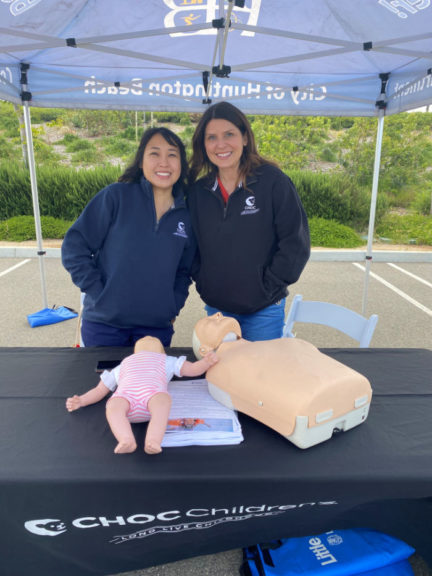Dr. Jason Cook was at the gym recently when he glanced up at a TV.
He saw a floating pool toy and a child reaching for it, about to fall into the water.
The public service announcement was a warning about drownings – the leading cause of death of kids under 5 in Orange County – and how critical it is for adults to vigilantly watch young ones when they’re in or around a pool, spa, or other body of water.
Dr. Cook, a critical care doctor at CHOC, knows all too well the often-tragic results of child submersions, nearly all of which are silent and can cause severe neurological injury or kill within minutes.
Dr. Cook didn’t see many pediatric drownings before he came to CHOC 11 years ago from Boston.
Now, sadly, in sunshine-soaked Orange County, he sees such patients frequently.
“Drowning is a tragedy that is 100% preventable. You have to take it seriously and have an action plan if you have young children. At least 10 families in Orange County have learned this all too well this summer. We don’t want to see any more.”
Dr. Gary Goodman, director of the PICU at CHOC at Mission Hospital
If the initial resuscitation efforts are unsuccessful, says Dr. Cook, there’s very little the physicians can do to restore brain function.
Given the COVID-19 pandemic, drowning prevention hasn’t received the media attention it usually does every summer, CHOC doctors and water safety advocates say.
But CHOC recently experienced a cluster of drownings, prompting physicians to sound the alarm about one of the most preventable of tragedies.
“We’re seeing an unusual number of near and fatal drownings,” says Dr. Paul Lubinsky, associate medical director of the pediatric intensive care unit (PICU) on CHOC’s Orange campus.
It’s unclear at this point if 2021 child drownings or near drownings will be unusually high compared to recent years.
From 2016 to 2020 in Orange County, the average has been 33 drownings per year for kids under 5 – with an average of four fatal drownings each year, according to data from the Orange County Fire Authority.
There were two recent fatal drownings of children in Orange County, bringing the number to three so far for children under 5 in 2021, Dr. Cook says.
Even one fatal drowning per year is too much, he and others say.
“Drowning is a tragedy that is 100% preventable,” says Dr. Gary Goodman, director of the PICU at CHOC at Mission Hospital. “You have to take it seriously and have an action plan if you have young children. At least 10 families in Orange County have learned this all too well this summer. We don’t want to see any more.”
The pain of losing a child to drowning is impossible to describe, a mother of a drowning victim says.
“I think it’s so crucial for people to really try to internalize what it might feel like for it to happen to you,” says Julie Lopiccolo, who lost her son, Jasper St. Clair, in a pool drowning in 2016.

Jasper was 21 months old.
“You can’t even quantify the pain and suffering that comes along with it,” Julie says.
An unfenced pool
Jasper, a smart, happy, and inquisitive toddler who was just starting to put words together, was in the care of a babysitter on March 19, 2014.
It was the 19-year-old babysitter’s regular day to watch him. She and her family lived directly behind Jasper’s house, which did not have a pool. The babysitter’s family had an unfenced pool.
Julie recalls having had one or two conversations with the babysitter about the pool, telling her that Jasper could never be watched at her house.
“I assumed she would listen, and I didn’t give it a second thought,” Julie recalls.
But that cool and cloudy morning, at around 10 a.m., the babysitter brought Jasper to her house.
Jasper escaped out of an unlocked door while the babysitter was using the restroom and slipped into the pool.
Julie got the call at work that her first-born child was in critical condition at CHOC. She, her husband Jonathan, and other loved ones kept vigil on Jasper, but he died a week later, on March 26, 2014.
Jasper’s death prompted Julie and Jonathan to launch the Jasper Ray Foundation later that year. The non-profit charity raises awareness about drowning and prevention, including lobbying for tougher state laws on pool and spa safety. First enacted in 1996, the state Pool Safety Act was amended in 2018 to require at least two of seven designated safety features, such as a permanent fence, compliant pool cover, and door and window alarms.
The law doesn’t go far enough, Julie and CHOC doctors believe. Julie participates on the Orange County Drowning Prevention Task Force, a consortium of nonprofits, government agencies, first responders and hospitals established in 2015. Also active on the task force are Dr. Cook, Dr. Goodman and Dr. Ted Heyming, medical director of emergency medicine at CHOC and the task force’s current co-chairperson.
Critical tools
Children drown under two very different scenarios, Dr. Goodman says.
Most often, and most seriously, a child is last seen in the home, and manages to escape to a Jacuzzi, spa or pool nearby. The seconds, then minutes tick by with scary speed until the child is finally discovered, often after irreversible brain damage has occurred: when a child has been submerged for longer than 5 minutes and has no pulse or breathing and is unconscious when rescued.
The second scenario is where the child and their family are around or in a body of water, but supervision is interrupted and the child slips under the water. Often they are quickly discovered, rescued, and resuscitated successfully, and although they may have some transient lung issues, they should make a full and complete recovery.
So, there are three critical tools to drowning prevention, Dr. Goodman says:
No. 1: Have multiple, redundant barriers around any home pool, spa or Jacuzzi to slow your child down.
No. 2: When your child is around water, provide constant, uninterrupted, undistracted supervision. “You are your child’s best lifeguard,” Dr. Goodman says.
No. 3: Learn CPR and use it immediately and effectively if your child, or anyone else, is not breathing or does not have a pulse. And call 911. Continue CPR until they arrive and assess the victim.
Successful day of outreach
Each year the OC Drowning Prevention Taskforce holds a multi-city Water Safety Day. This is a fun, interactive event that teaches water safety tips including how to supervisor children around the water, how to properly use life vests, how to create barriers around a pool and how to perform CPR. Because of the pandemic this year’s event transitioned into a mix of drive-through events, socially distanced walk-through events and the first ever virtual event. Nine cities in Orange County participated.
An estimated 1,000 members of the public participated, and CHOC nurses volunteered to teach CPR at six of the locations. The nurses were among the 135 volunteers who helped make the May 22, 2021 event a success, says Makenzie Ferguson, RN, injury prevention coordinator in emergency and trauma services at CHOC. Additionally, members of CHOC Transport Services attended the event in Orange.

The Jasper Ray Foundation was a co-sponsor of Water Safety Day and Julie and Jonathan brought their own children to attend and learn about water safety.
For Jasper’s little sister and brother, Luna, 5 ½, and Archer, 3, water safety is a way of life. They began swim lessons at an early age and their parents talk to them frequently about never going into the water alone.
“Before, I was not overly concerned with drowning prevention because we did not have a pool,” Julie says. “Today, I understand how serious the risk of drowning is for every child who has any access to water. So now, I don’t care who you are, I will make you listen to my drowning prevention diatribe. I have the perspective now.”
She gets emotional when she mentions a niece who visited Jasper in the hospital who, more than seven years later, still struggles with anxiety.
And she says her mother, Toni, who watched Jasper twice a week, is still struggling with processing his death.
Julie is eager to share her story in the hopes that parents and caretakers will take the possibility of drowning more seriously and better protect their young ones.
The motto of the Jasper Ray Foundation, after all, is, “It’s your job to keep me safe.”
Infants and toddlers, of course, don’t know any better.
Jasper sure didn’t.
“He went outside and probably went directly into the pool,” Julie says.
“He had no idea. It just looked fun to him.”
Learn what drowning looks like and get tip sheets
Get more expert health advice delivered to your inbox monthly by subscribing to the KidsHealth newsletter here.
Get more safety and injury prevention tips from CHOC experts
More children are affected by injuries than all other childhood illnesses and diseases combined. Most of these injuries are predictable and preventable. Here’s how to keep your child safe.





